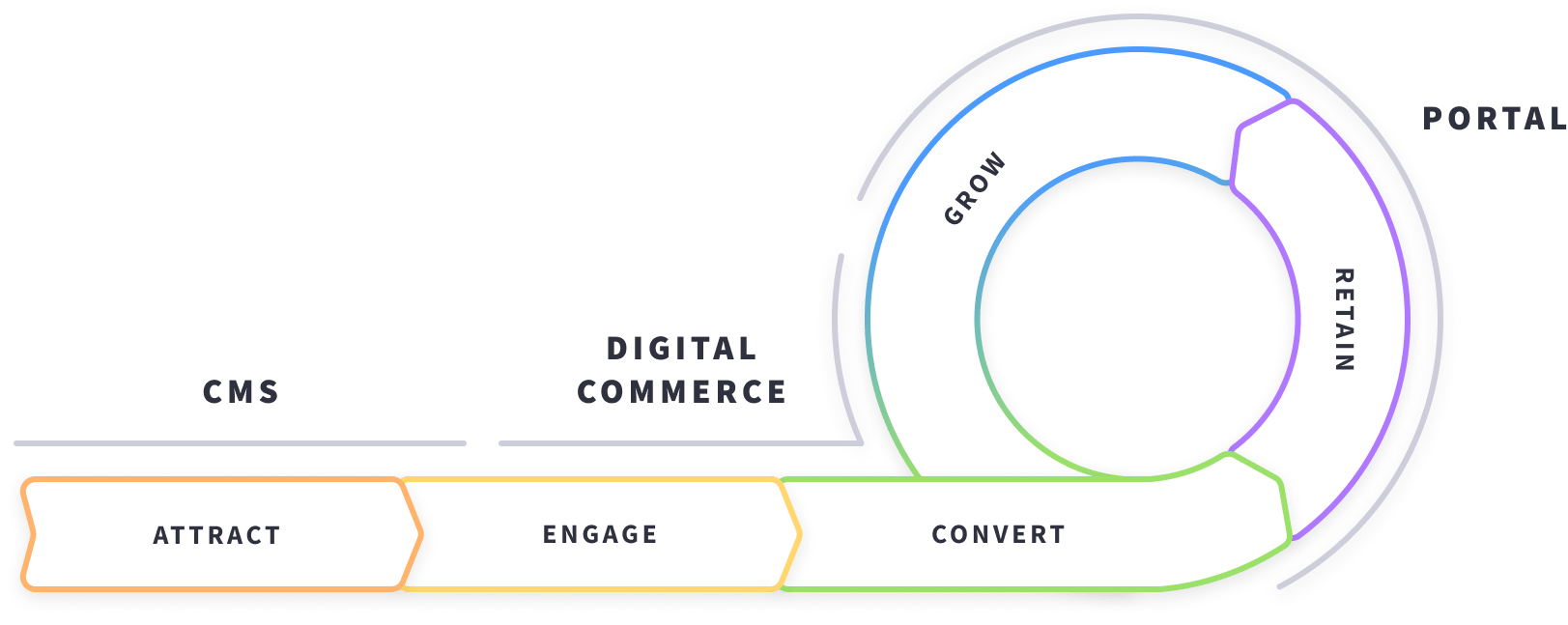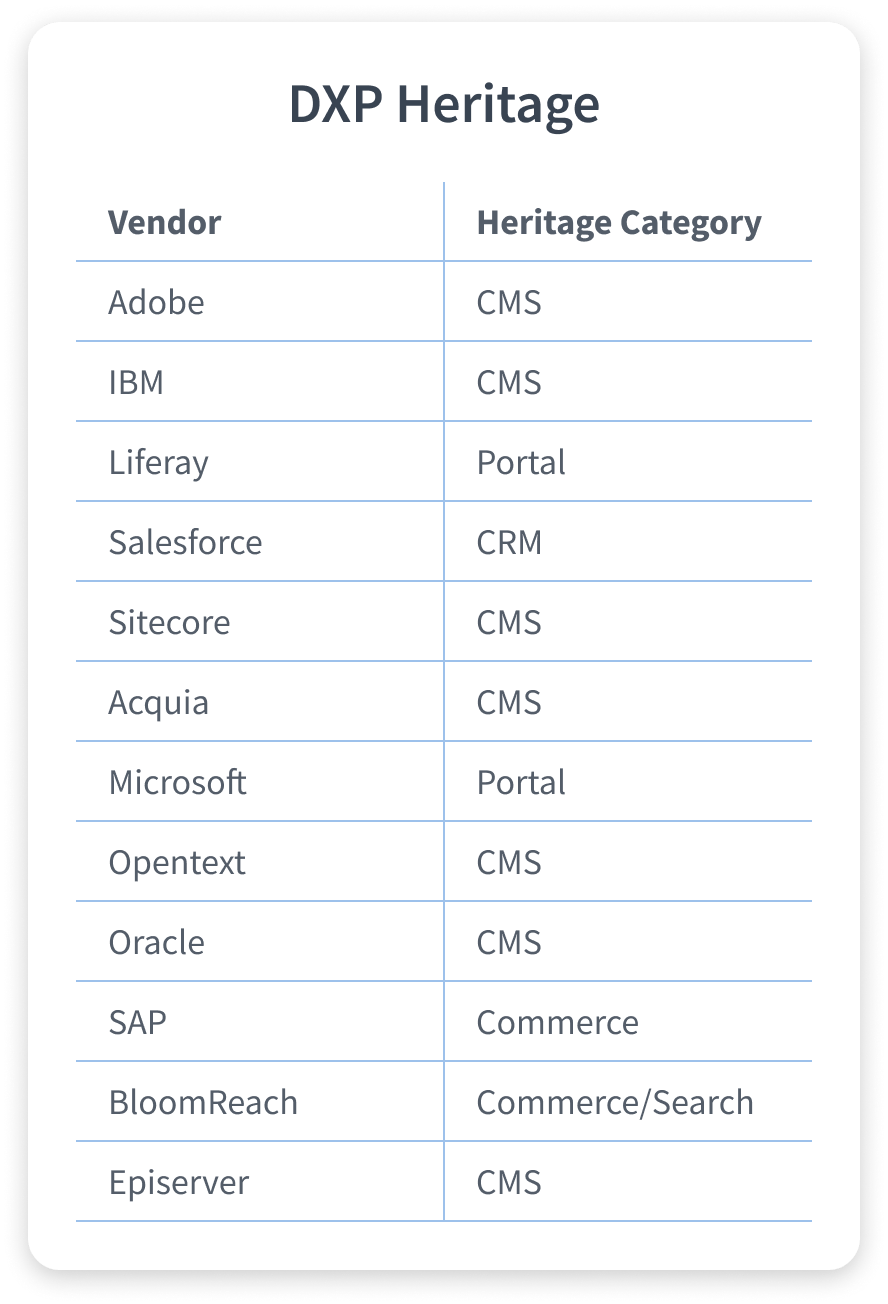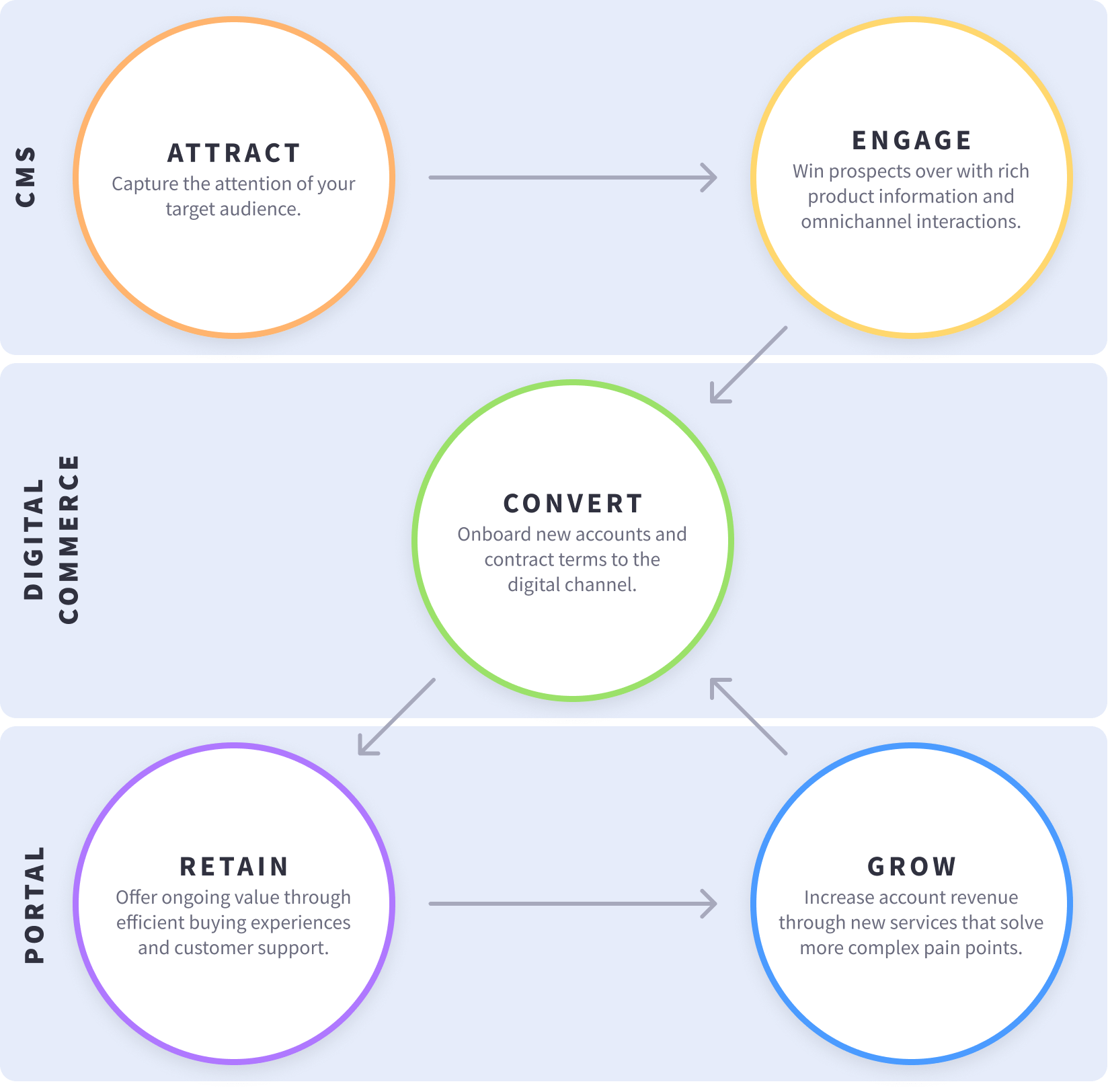Transform B2B Commerce With a Digital Experience Platform


However, pure play digital commerce platforms have traditionally lacked the robust site building, personalization and authenticated experiences needed to do digital commerce well across the entire customer journey. To stay competitive, companies need to move beyond thinking about digital commerce in a silo and address it in the context of the full customer journey with a comprehensive digital experience platform.
By switching to a digital experience platform that brings together the best of content management, commerce, and portal capabilities, companies can successfully navigate the transition to B2B digital commerce and deliver an excellent customer experience across the entire customer journey.
The Original Promise of Digital Experience Platforms
Five years ago, analysts started buzzing about a new software category called digital experience platforms, or DXPs. This new platform aimed to provide an architecture for companies to digitize business operations, connect customer experiences, and gather actionable customer insights. More broadly, DXPs promised to enable companies to address the full customer journey, from attracting new customers to converting them and growing each account over time.
Today’s leaders in the DXP category tend to come from one of three heritage categories: Content Management Systems (CMS), Portal Platforms or Commerce Engines. Each of these is typically identified with a distinct part of the customer journey. While CMSs have dominated the marketing needs of the pre-purchase stages, portal platforms are overwhelmingly chosen for post-purchase experiences such as customer self-service portals. And of course, commerce engines excel at the point of purchase and at converting prospects into customers.
Over time, vendors from each category have broadened their offerings to cover adjacent features and create different flavors of DXPs:
- CMS suites have integrated commerce functionality and personalization to deepen customer engagement. CMS-heritage DXPs focus primarily on the needs of marketing departments and creative agencies.
- Commerce engines have added lightweight CMS functionality and site building to create customer-facing experiences. Commerce-heritage DXPs are used in online shopping scenarios by companies in retail and related industries.
- Portal platforms have added content management and dynamic personalization to complement authenticated experiences. Portal-heritage DXPs are particularly suited for nurturing long-term customer relationships after the sale, with integrated customer data tied to individual profiles.

This convergence has made it clear that all three categories are foundational for delivering on the promise of addressing the full customer journey. For B2B companies in particular, being able to leverage CMS and portal capabilities before and after purchase makes it easier to create enriched product content and offerings within a single delivery system, rather than working across an ERP, PIM, CMS, commerce engine, and other legacy systems.
More importantly, by bringing these product suites into one platform, DXPs are uniquely suited to unifying customer and business data within a single paradigm, making it possible to measure the performance of their business processes and identify opportunities to optimize and grow.
Not All DXPs Are Created Equal
An analysis of the Gartner MQ for Digital Experience Platforms reveals that the category is currently dominated by CMS-heritage platforms.
One consequence of this is that the early adopters of DXPs often fell into marketing use cases that focus on the pre-purchase phases of the customer journey, particularly in the B2C space (the traditional strength of CMS vendors).
Overall, this has led to an over-emphasis of the attract and engage stages within the DXP category as vendors race to provide pre-purchase experiences and neglect the purchase and post-purchase experiences.
Even within the CMS vendors that have some historical portal capabilities (i.e., IBM and Oracle), those capabilities have been applied to internal B2E experiences rather than customer-facing solutions.
For B2B companies working on a customer experience initiative, a CMS-heritage DXP will likely be too marketing-driven to solve their pain points. Platforms with a strong emphasis in either commerce or portal will offer more value because B2B customer experience is so tightly tied to long-term purchasing capabilities.

Portal and Commerce Capabilities Are Critical for the B2B Customer Experience
The best opportunities for B2B companies to grow their business and stand out from the competition lie in the post-purchase phase. The B2B seller-buyer relationship depends on multi-contact experiences that allow customers to move seamlessly between self service and in-person experiences. Additionally, most B2B customers will use buying teams to make purchasing decisions. This means that a B2B digital commerce platform must support different customer roles and journeys, with personalization and advanced permissioning tailored for each.
It must also support the service and sales reps that collaborate on orders and troubleshoot issues with each account. By bringing them into the channel, companies enable them to become co-creators of the digital experience and allow customers to receive in-person support in situations where self service doesn’t suffice.
Supporting these complex, multi-contact customer journeys opens up paths to nurture and grow accounts for long-term, ongoing revenue, as opposed to the high levels of churn that B2C companies must contend with.
Breaking Down the B2B Customer Journey
The biggest difference between the B2C and B2B customer journey is that, in B2B, new customer acquisition assumes a long-term relationship with each account. Once a contract is in place, it’s much harder to switch vendors in B2B (though churn is always a risk).
B2C, on the other hand, has to win customers over again after every purchase in most verticals, which is why their customer engagement solutions focus primarily on marketing, rather than post-purchase service.
Because of this difference, the primary interaction that B2B buyers have with their vendors is regular purchasing through the online commerce site. The biggest opportunity to improve — or damage — their experience exists during those moments of purchase. This is where the convergence of portal, commerce and CMS becomes truly critical.
To understand this better, let’s take a closer look at the most important capabilities that CMS, portals, and digital commerce platforms contribute to the B2B customer journey.

Portals
We’ll start with the back end of the customer journey, since it tends to be the most overlooked. The Retain and Grow stages require rich, authenticated experiences that encourage ongoing engagement and consolidate customer data to keep executives informed of the health of their business. Portal functionality is weighted towards these post-purchase phases because of the flexibility of permissions and role-based access that they bring to the table. Most portals are also used as collaboration platforms and often have business process tools such as form builders and workflow management.

Content Management Systems
Despite their name, CMSs bring more than web content and digital asset management to the DXP mix. Because they are meant to engage anonymous users, they are strong in dynamic personalization and the ability to tailor experiences based on real-time user behavior. CMSs also tend to be favored by marketers and other business users, which has led to the development of business-user friendly, low code approaches to site building and personalization.

Digital Commerce
Like portals, digital commerce requires strong integration with other systems and must accommodate complex organizational hierarchies, architectures, and taxonomies. Advanced search capabilities and attention to security are also traditional strengths of commerce solutions. On its own, a digital commerce engine usually isn’t built to deliver customer-facing experiences. To do digital commerce well, companies need an integrated solution with site building, personalization, and authenticated experiences.

Bringing It All Together
CMS, Portal, and Commerce are foundational capabilities for companies in the midst of digital transformation — the backbone of CX strategy that every B2B company needs to deliver great experiences. With these core capabilities united on one platform, companies have the flexibility they need to craft complex experiences that are uniquely tailored to their B2B audiences.
When these touchpoints are delivered through a single platform, companies can also easily bring in sales and service roles with contextualized views of every customer account, bridging the gap between the traditional and online channels. What you end up with is a digital platform that maps to the complexity of the B2B customer journey, positioning you to get an accurate look at how all your business processes work together and where your customer experience is falling short.

Create a Path to Digital Transformation
The race to improve B2B customer experience is poised to accelerate in the coming years, with 79% of manufacturers and 84% of distributors/wholesalers planning to increase spending on customer experience in 2019.
Leaders in the B2B space have shown that the potential to grow your business through better B2B experiences is huge for those companies that are willing to invest the time and resources to making it happen.
B2B customers are asking for modern, online commerce experiences whether companies are ready to deliver them or not. The only question is how quickly companies can transition their traditional processes to digital experiences before their customers leave them behind.

